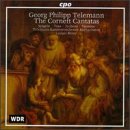| All Artists: Georg Philipp Telemann, Ludger Remy, Bläser-Collegium Leipzig, Mona Spagele, Wilfried Jochens Title: Telemann: The Cornett Cantatas Members Wishing: 1 Total Copies: 0 Label: Cpo Records Release Date: 12/1/1998 Genre: Classical Styles: Opera & Classical Vocal, Historical Periods, Baroque (c.1600-1750), Symphonies Number of Discs: 1 SwapaCD Credits: 1 UPC: 761203954223 |
Search - Georg Philipp Telemann, Ludger Remy, Bläser-Collegium Leipzig :: Telemann: The Cornett Cantatas
 | Georg Philipp Telemann, Ludger Remy, Bläser-Collegium Leipzig Telemann: The Cornett Cantatas Genre: Classical
|
Larger Image |
CD Details |
CD ReviewsCornett Cantatas! How Enticing! Giordano Bruno | Wherever I am, I am. | 07/26/2008 (5 out of 5 stars) "Especially for a cornettist!
Honestly, however, I've been aware of these three cantatas by GP Telemann (1681-1767) all along. Packaging them together is a bit deceptive; they were not written together, or for the same occasion, or even for the same cantata cycle. "Erhoere mich, wenn ich rufe" dates from 1717. The other two cantatas were written for the church year of 1720/1721, with a different librettist. They are, nevertheless, similarly high-spirited works, not quite festive enough to haul out the trumpets and timpani, but joyous enough to call in the clowns...er, brass players...probably from an existing ensemble of town-pipers. The burning questions, from a musical history point of view, are 1) why Telemann chose to use the nearly moribund "cornetto" and 2) who could possibly have been the player of that difficult instrument who performed the none-too-easy scores. My unresearched guess is that the second question answers the first; Telemann found that he had a 'living historical treasure' of a cornettist at hand, and leapt to use him. The "cornetto" played on this CD, and in Germany almost exclusively during the Baroque era, was not the North Italian cornetto in G used by Monteverdi and played brilliantly today by Bruce Dickey and Doron Sherwin of Concerto Palatino. It was the stubby cornettino in C (with D as its lowest note), a ridiculously hard critter to play with any aplomb, about the length of an alto recorder and with a mouthpiece the size of a Dutch dime. Let me hasten to say that cornettinist Arno Paduch performs miracles, playing nicely in tune and pushing a sweet timbre through his wee beastie. The particular idiom of Italian cornetto playing, with its mesmerizing rapid ornamentation and divisional improvization, was long dead by Telemann's time, of course, and the only thing that separates Paduch's cornettino from an other obbligato instrument is its timbre, trumpet-like but softer and more vocal. These are outstanding examples of Telemann's German style of composition, seen mostly in his chamber cantatas, which are on a par with Bach's. The orchestra of the Michaelstein Monastery Institute for Performance Practice has always specialized in the works of Telemann, and their familiarity with that repertoire serves them well; they play the stuff with confidence and grace. The four vocalists likewise are Bach-era specialists, and prove it with vigor. My only small criticism, and it's aesthetic rather than technical, is that I don't especially enjoy the sound of alto Henning Voss's voice per se. On the slower chorale-like movements, he sounds hollow to me. On the more exhuberant embellished passages, however, his superb athleticism justifies his role in the performance. The cornettino, and most wind instruments of the German Baroque, was tuned to A466, a half step higher than modern winds. Paduch and the three trombonists of Blaeserkollegium Leipzig use replica instruments at the higher pitch. Now then, anyone 'blessed' with perfect pitch, I'll leave you with the challenge to trying to hear whether the singers and strings also perform at A466 or whether the cornettino and trombones are transposing a half step. Good luck!" |

 Track Listings (23) - Disc #1
Track Listings (23) - Disc #1